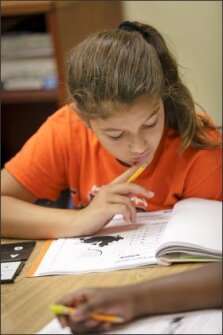There are some basic properties of whole numbers any 3rd grader can tell you: Each number is represented by a single symbol, and followed by a single successor. Multiplication makes a number bigger; division makes it smaller.
The problem is, none of those qualities is true when it comes to fractions, one of the most chronically troublesome basic mathematics areas for children and adults. Now, as the Common Core State Standards push for earlier and deeper understanding of fractions, researchers and teachers are exploring ways to ensure students learn more than a sliver of the fractions pie.
“Developmental research shows even very young children have a fundamental grasp of fractions that can be built on through instruction,” said Nancy C. Jordan, a professor of education at the University of Delaware. But, she added, “if children are taught math in a way that’s very rote, where they memorize procedures, … it really doesn’t help you much.”
‘Whole New World’
The traditional approach to teaching fractions can make it more likely for students to show superficial progress without real understanding, some researchers and educators argue.
“We’ve had a tendency in our traditional scope and sequence of math that you teach all this whole-number stuff … and then, all of a sudden, you get to fractions, and it’s a whole new world of what to do—everything they learned in whole numbers has nothing to do with how you do fractions,” said Linda M. Gojak, the president of the National Council of Teachers of Mathematics, in Reston, Va., and the director of the Center of Mathematics and Science Education, Teaching, and Technology at John Carroll University in University Heights, Ohio. “It’s one of the hardest things for kids to get their heads around.”
Cynthia Hacker, the education director for Sylvan Learning Center of Irmo in Columbia, S.C., sees that confusion a lot. For more than a dozen years, the center has run a weeklong “Fraction Action” summer camp, at which students play games using shapes and number lines to compare fractions of different sizes and practice multiplying and dividing mixed and improper fractions.
A lack of fractions understanding has been cited as second only to word-problem difficulty as the top handicap for students learning algebra, in a survey of a representative sample of 1,000 algebra teachers conducted by the National Mathematics Advisory Panel.
The typical American approach to teaching fractions can overemphasize procedures at the expense of an understanding of the relationships among numbers, which is needed for higher math, according to Lynn Fuchs, a professor of special education at Vanderbilt University in Nashville, Tenn.

In the United States, curricula mostly focus on understanding fractions as parts of a whole, using area models and pie charts, and teaching students the procedures for adding or multiplying, for example.
That’s soon to become an even bigger hurdle, as the common core in math push more work on fractions into 3rd grade, as opposed to 4th and 5th grades. The common standards also call for teachers to focus less on the procedures for specific fraction problems and more on getting students to understand the relationships between numbers that underlie a fraction problem.
Some Asian countries, by contrast, focus on what Ms. Fuchs calls a “measurement interpretation” of fractions: how they fall on a number line; the relationships between numbers represented by a fraction.
“It’s actually a very different way to teach fractions,” Ms. Gojak said.
In a 2012 essay, Robert Siegler, a professor of cognitive psychology at Carnegie Mellon University, in Pittsburgh, and his colleagues call fractions a “new frontier” for understanding students’ numeracy development.
Building Better Fractions
The National Center on Improving the Learning of Fractions, a multi-university project based at the University of Delaware, in Newark, and supported by the federal Institute of Education Sciences, is trying to help students and teachers become more adroit with fractions.
Ms. Jordan, Mr. Siegler, and Ms. Fuchs are working with Nashville and other public school districts to explore more effective ways to teach those concepts.

Beyond simply being able to count, Mr. Siegler said, fraction knowledge in 5th grade “uniquely predicts” a student’s 10th grade math achievement, beyond the student’s IQ, family background, or even knowledge of other parts of mathematics.
Ms. Jordan’s research has found that students’ ability to understand and estimate where fractions would fall on a number line and explain magnitude—that a number represents a set of items that can be changed or compared to other sets—will predict how well they perform in math over the long term. She is developing a screening tool for 4th to 6th graders to identify children who are having trouble learning fractions and the instructional areas their teachers need to emphasize.
Mr. Siegler and his team at Carnegie Mellon are developing a board game to help early-elementary students understand and compare the magnitude of different fractions. The computer-based game, Catch the Monster, asks students to find a monster hiding along a number line by estimating the point closest to a location, using a fraction-related hint.
In one of Ms. Fuchs’ studies, students in 53 4th grade classes in 13 schools were randomly assigned to take part in either their schools’ regular fractions instruction or a 12-week intervention focused on teaching the underlying relationships in fractions. The intervention students performed significantly better than peers who had received the regular instruction on a test of fractions problems culled from the National Assessment of Educational Progress. Plus, the achievement gaps between students considered “at risk” in math—those initially in the lowest 35th percentile on a standardized test—and those not at risk closed significantly for program participants.
“We are teaching children to think of fractions in terms of quantities, how different-sized fractions compare to one another,” Ms. Fuchs said. “We’re trying to teach them a more sophisticated understanding of fractions and help them do well.”






